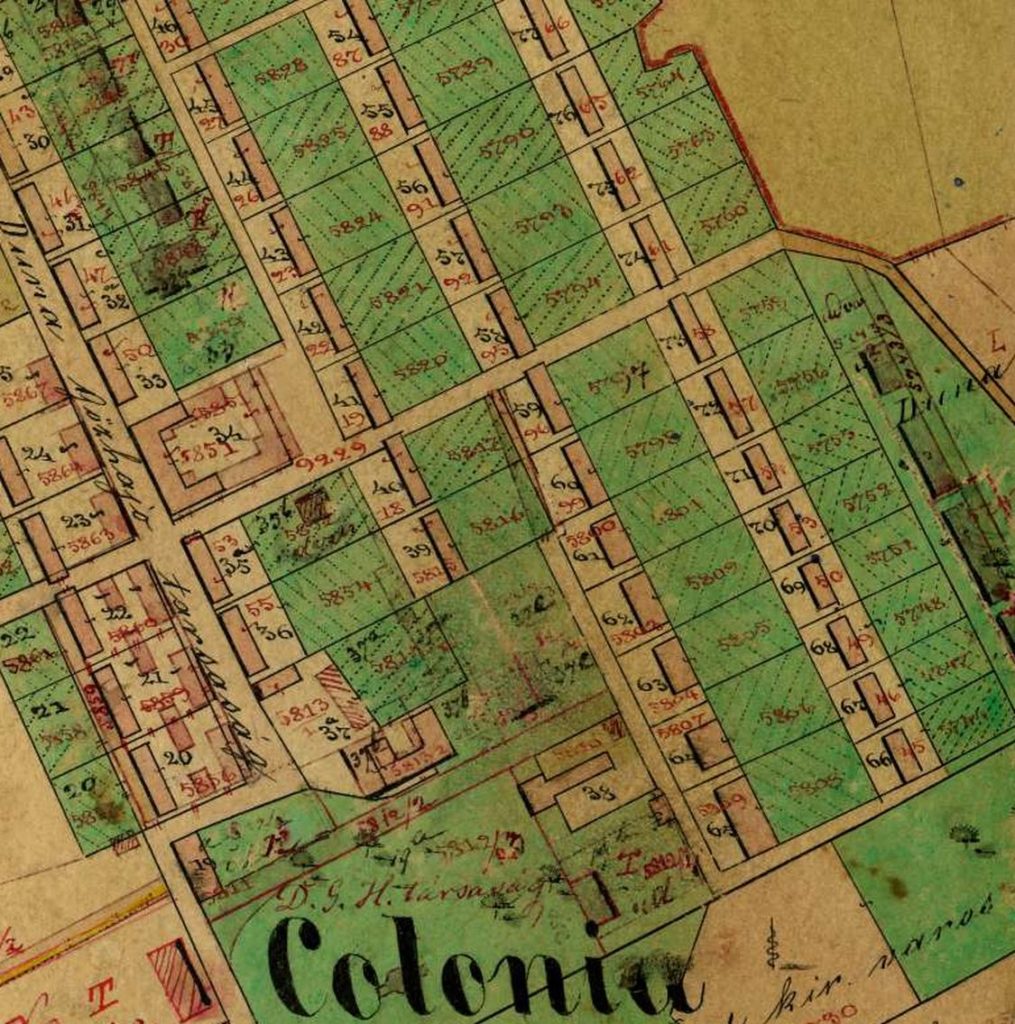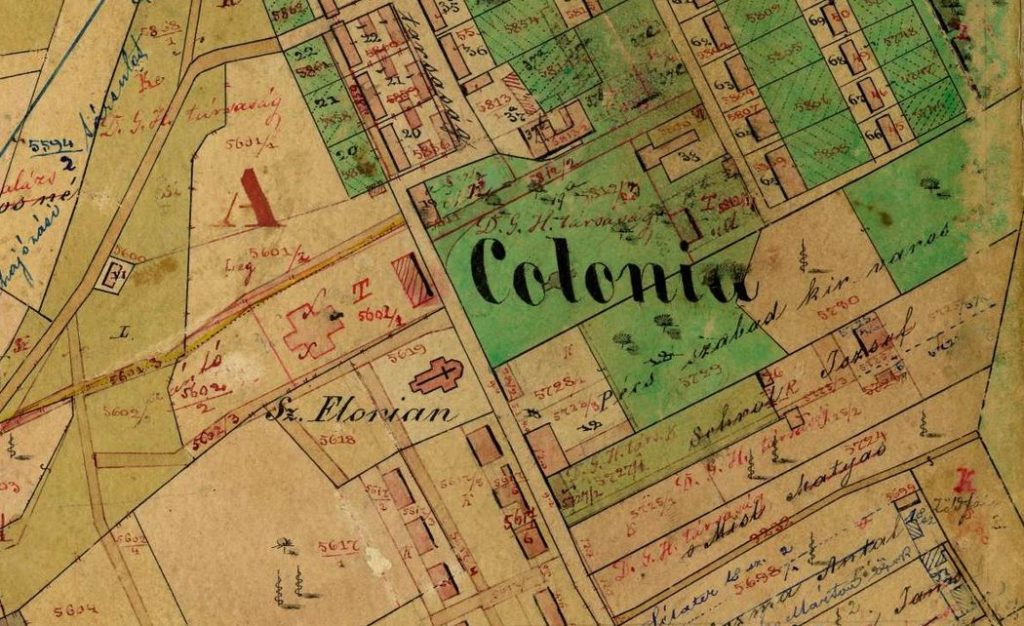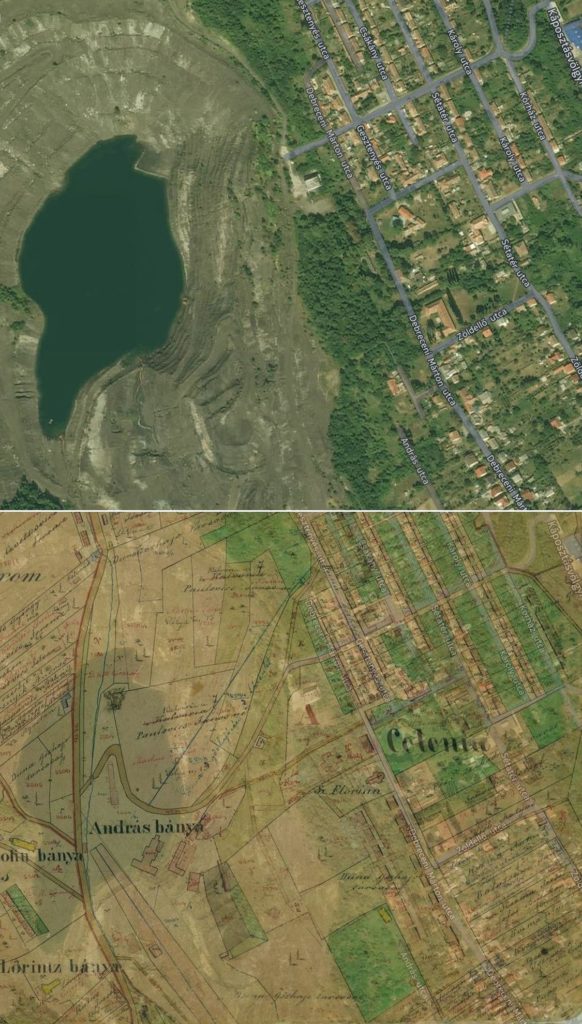“Glück Auf” has been the traditional greeting used by miners. No doubt my ancestors, who were coal miners, used this expression daily. In German, it means “good luck.” Not only did miners wish each other luck in finding and extracting the minerals they sought, but it was a wish that they also come back alive.
Pécsbánya is a coal-mining district about three miles northeast of Pécs, Hungary. The area was also called Pécsbányatelep. Literally translated they mean Pécs-mine and Pécs-mine-settlement. Pécs was known as Fünfkirchen by the Germans. For 250 years, more than 35 different coal mines operated at one time or another and 40 million tons of coal were produced here.
The Danube Steamship Company (Dunai Gőzhajó Társaság, or DGT) was a large consumer of coal. In 1852 it expanded into ownership of coal mines. To house workers for its growing operations, DGT started a “colony” in 1855, named Colonia. It was located on Gesztenyés hill ridge near the András (Andrew) mine. The first settlers there were Hungarians, Germans, Czech-Moravians, Slovakians, Bosnians and Slovenians.
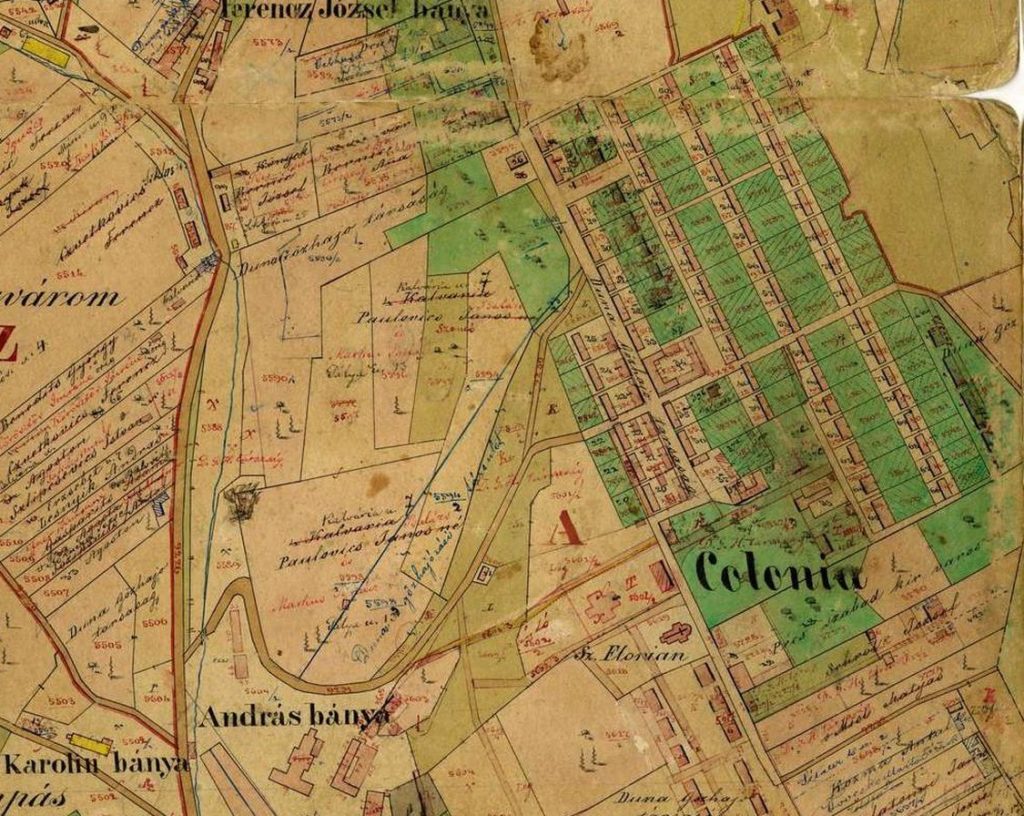
Colonia, 18651
Colonia was a “company town” that provided an existence for workers “from cradle to grave.” Finished by 1870, it had relatively modern conveniences, like running water in 1859 and gas-lit street lighting in 1878. It had a church, school, pub, grocery-store, steam-mill, smoke-house, hospital, cemetery, and other sport and cultural buildings.2 The residential area consisted of several rows of identical housing units. Colonia is today known as Pécsbánya.
Early settlers in Colonia were my great great-grandparents, Stephan and Mária (Turek) Bittner. They were both born in what was then Szomolnok, Hungary, but it is today Smolník, Slovakia. They perhaps lived for a time in Serbia and then came to Colonia by 1861. My great-grandmother Mária (Bittner) Pohl was born in Colonia in 1867, and probably in house number 57.3
My great great-grandparents Albert and Sophia (Rohr) Pohl also came to Colonia no earlier than 1864. They came with their young children, including my future great-grandfather Albert Pohl. They were from Setzdorf in Austrian Silesia, which is today Vápenná, Czech Republic.
Both great great-grandfathers Stephen Bittner and Albert Pohl were coal miners, as was my great-grandfather Albert Pohl. It is uncertain at which mines they worked. Since there were so many, they probably worked at different mines throughout their careers. If Colonia was built and managed by DGT, they may have worked only at DGT-owned mines. The András Akna was closest to Colonia. It was in operation from 1852 to 1991. Other nearby DGT mines included Schroll Akna (1869-1926), Zwang Akna (1850-1897), Albrecht Fék Akna (1856-1894), and the Ferenc (2) Táró (1860-1870).4
“Akna” means mine and “táró” means tunnel in Hungarian, presumably a shaft and a drift mine, respectively. A shaft mine uses a vertical downward shaft while a drift mine uses a horizontal shaft that follows a coal seam back into a mountain.
The Catholic Church in Colonia was Szent Flórián (Saint Florian). It was built in 1861 and would have been the church where great-grandmother Mária (Bittner) Pohl was baptized in 1867. When she grew up, it was where she married my great-grandfather Albert Pohl in 1885. Due to mining operations near it, the church was damaged and had to be demolished in 1890. A new church was eventually built further away on the northern edge of Colonia in 1902. Today it looks as though even that church is no longer used. However music still plays from its tower daily in honor of the miners.5 6

András Akna7

Schroll Akna with Colonia8

Zwang Akna9
The place of residence given by our ancestors on birth, marriage and death records varied. Parents and children lived and worked in different places at different times over a 40 year period: Colonia, Nagybánya, Szabolcs, and Pécsbányatelep. However all these places were within a few miles of one another and are generally in and around what is today Pécsbánya. For example my great-grandmother Mária (Bittner) Pohl was born in Colonia. When she got married, she resided in Nagybánya, and when she gave birth to my grandmother Ida, the family lived in Szabolcs.
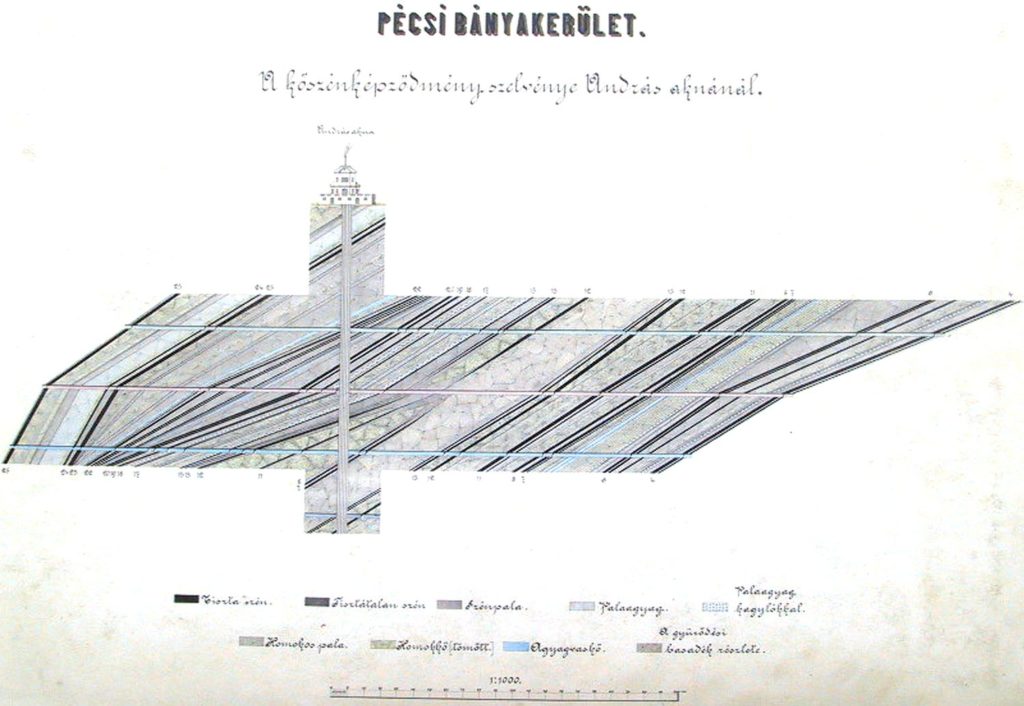
András Akna10
Some DGT-owned mines began to close down in the early 1890s, presumably as their coal seams were depleted. Perhaps this is a reason why my great-grandfather Albert Pohl left for better opportunities in America. Albert sailed alone to America in 1892 and made his way to the coal mines of Pittsburgh, Pennsylvania. He later sent for his wife Mária and her children, including my grandmother Ida, the following year. They in turn made the voyage in 1893, leaving both Albert’s parents and Mária’s mother behind in Pécsbánya. Mária’s father had died in 1889. It is doubtful they ever returned.

House 57, as it appears today11
This could be the actual house where Stephan and Mária (Turek) Bittner lived when their daughter, my great-grandmother Mária, was born in 1867. It is near the intersection of Sétatér Utca and Pécsbányatelepi Utca (“Utca” means street). This building looks similar to those shown in the András Akna photograph above. It is probably more than 150 years old and is therefore likely the very same dwelling occupied by the Bittners. Each building was originally home to four families, but appears to be a duplex for two families today. Shown here is the right-side dwelling.
Today the prominent geographical feature in the area is the former open-pit surface mine, the Karolina. Open-pit mining began in the 1950s. Several old mining sites were obliterated by the open-pit. All mining ceased here in 2004.
Interestingly, in 1988 dinosaur footprints were discovered in the Karolina pit mine. They may have been left by a group of Komlosaurus dinosaurs walking around what was then a seashore.
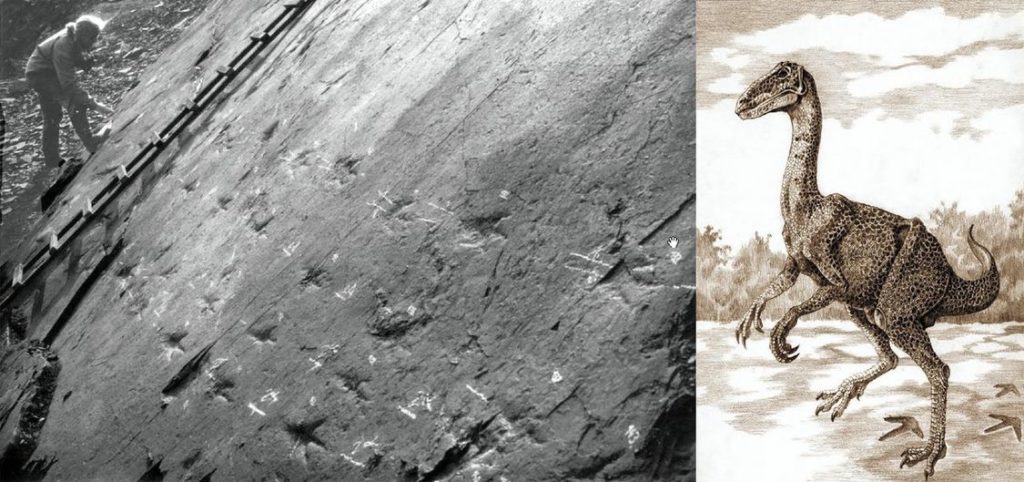
Dinosaur Tracks12
Dinosaurs eventually became the fossil fuel that provided a livelihood for my ancestors, who were among the first coal miners to live and work in the Pécsbánya area during its heyday. My great great-grandparents spent the rest of their lives there. Their children, my great-grandparents ventured onward to America, only to continue working the coal mines of Western Pennsylvania. It is through their hard work and good luck that their descendants follow in their footsteps today. Glück Auf! Indeed.
Footnotes- Historical Maps of the Habsburg Empire, Cadastral maps (XIX. century), “Pécs, 1865” (http://mapire.eu/hu/map/cadastral/ : viewed 5 April 2017), citing Arcanum Adatbázis Kft. (http://www.arcanum.hu/en/), and citing Magyar Nemzeti Levéltár (http://mnl.gov.hu/), and citing Timár, G., Biszak, S. (2010): Digitizing and georeferencing of the historical cadastral maps (1856-60) of Hungary. In: Livieratos, E., Gartner, G. (eds.): Proceedings of the 5th International Workshop on Digital Approaches in Cartographic Heritage, 559-564. DOI: 10.13140/2.1.3888.8967.
- Zsuzsanna Jácint, Hungary, to Mike Voisin, e-mail, 5 April 2017, About Pécs and surroundings; privately held by Mike Voisin, Huntsville, Alabama.
- Zsuzsanna Jácint, Hungary, to Mike Voisin, e-mail, 17 January 2017, Ancestors; Stewart Family Line; privately held by Mike Voisin, Huntsville, Alabama, citing an 1867 record from a Catholic Church record book from Pécs, Hungary.
- banyaszbeka, “Pécs, Pécsbányatelep 2007,” blog (http://banyaszbeka.blog.hu/2007/03/02/pecs_pecsbanyatelep_2007 : 5 April 2017), close-up pictures of memorial stones, maps, and map legends.
- Béla Szirtes, “Pécs Mine Strolls and Mining Memorials,” Pécsi Bányásztörténeti Alapítvány (http://www.pecsibanyasz.hu/utikalauz.php : 5 April 2017).
- Pálfy Attila, “2. Pécsbánya,” Pécsi Bányásztörténeti Alapítvány (http://www.pecsibanyasz.hu/utikalauz.php : 5 April 2017).
- Csorba Győző Könyvtár [Library], Pécs, “16-1. András akna, háttérben a kolónia a régi templommal [András mine, the background of Colonia and the old church],” (http://www.csgyk.hu/web/banyaszattortenet/kepek/Akn%C3%A1k/Andr%c3%a1s%20akna/ : 5 April 2017.
- Csorba Győző Könyvtár [Library], Pécs, “55. Schroll akna, háttérben a Colónia [Schroll mine, background of Colonia],” (http://www.csgyk.hu/web/banyaszattortenet/kepek/Akn%c3%a1k/Schroll%20akna/ : 5 April 2017.
- Csorba Győző Könyvtár [Library], Pécs, “5. Zwang aknai munkások [Zwang mine workers],” (http://www.csgyk.hu/web/banyaszattortenet/kepek/Akn%c3%a1k/Zwang%20akna/ : 5 April 2017.
- Csorba Győző Könyvtár [Library], Pécs, “D.G.T. Pécsi Köszénbányái Hegyrétegek keresztszelvényei [Pécs Mines Mountain Layer Cross-sections],” DGT_3 (http://www.csgyk.hu/web/banyaszattortenet/doc/ : 5 April 2017), page 4.
- Google StreetView, Pécsbánya, Hungary, 2011 (https://www.google.com/maps/@46.1109229,18.2478035,3a,75y,33.55h,75.92t/data=!3m6!1e1!3m4!1sN0bJQzWbw5ppa_rro5fh-Q!2e0!7i13312!8i6656!6m1!1e1 : 19 April 2017).
- István Fzy and István Szente, “Fossils of the Carpathian Region” (Indiana University Press, 2013), pages 138 and 140.


